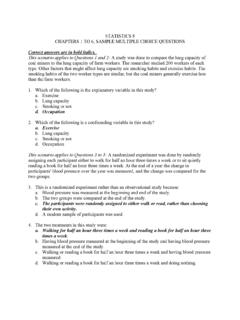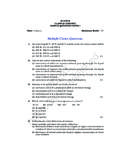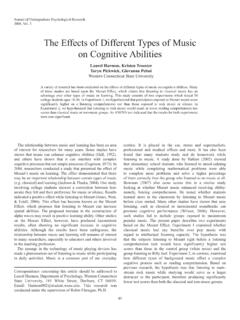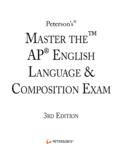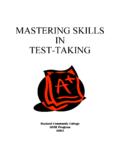Transcription of The Meaning of “Significance” for Different Types of ...
1 The Meaning of Significance for Different Types of Research[Translated and Annotated by Eric Jan Wagenmakers, DennyBorsboom, Josine Verhagen, Rogier Kievit, Marjan Bakker,Angelique Cramer, Dora Matzke, Don Mellenbergh, and HanL. J. van der Maas]Dr. A. D. de GrootFrom the Psychological Laboratory of the University of AmsterdamAbstractAdrianus Dingeman de Groot (1914 2006) was one of the most influentialDutch psychologists. He became famous for his work Thought and Choicein Chess , but his main contribution was methodological De Groot co-founded the Department of Psychological Methods at the University of Ams-terdam (together with R. F. van Naerssen), founded one of the leading testingand assessment companies (CITO), and wrote the monograph Methodol-ogy that centers on the empirical-scientific cycle: observation induction deduction testing evaluation. Here we translate one of De Groot s early ar-ticles, published in 1956 in the Dutch journalNederlands Tijdschrift voor dePsychologie en Haar Grensgebieden.
2 This article is more topical now thanit was almost 60 years ago. De Groot stresses the difference between ex-ploratory and confirmatory ( hypothesis testing ) research and argues thatstatistical inference is only sensible for the latter: One is allowed to ap-ply statistical tests in exploratory research, just as long as one realizes thatthey do not have evidential impact . De Groot may have also been one ofthe first psychologists to argue explicitly for preregistration of experimentsand the associated plan of statistical analysis. The appendix provides an-notations that connect De Groot s arguments to the current-day debate ontransparency and reproducibility in psychological :De Groot, exploratory research, confirmatory research, infer-ence and Meaning of the outcomes of statistical tests applied to psychological experi-ments is subject to constant confusion. The following remarks are meant to clarify theissues at remarks only pertain to the well-known argument, where a hypothesis istested , or: the significance of certain empirical findings is assessed by means of a nullADRIAAN DE GROOT2hypothesis (H0) and an assumed significance level.
3 UsuallyH0is rejected wheneverthe calculatedP-value is lower than the assumed threshold value . This is considered a positive result and we will use the same terminology throughout this question of interest, however, is what such a positive result is worth, in termsof argument, in terms of support for the hypothesis at hand. This depends on a numberof factors. In this respect we wish to make a distinction, first of all, as tothe \type" ofresearchthat provides the framework in which the relevant test is Hypothesis Testing Research versus Material-ExplorationScientific research and reasoning continually pass through the phases of the well-known empirical-scientific cycle of thought: observation induction deduction testing(observe guess predict check). The use of statistical tests is of course first and foremostsuited for testing , , the fourth phase. In this phase one assesses whether certainconsequences (predictions), derived from one or more precisely postulated hypotheses, cometo pass.
4 It is essential that these hypotheses have been precisely formulated and thatthe details of the testing procedure (which should be as objective as possible) have beenregistered in advance. This style of research, characteristic for the (third and) fourth phaseof the cycle, we callhypothesis testing should be distinguished from a different type of research, which is commonespecially in (Dutch) psychology and which sometimes also uses statistical tests, namelymaterial-exploration. Although assumptions and hypotheses, or at least expectations aboutthe associations that may be present in the data, play a role here as well, the materialhas not been obtained specifically and has not been processed specifically as concerns thetesting of one or more hypotheses that have been precisely postulated in advance. Instead,the attitude of the researcher is: This is interesting material; let us see what we canfind. With this attitude one tries to trace associations ( , validities); possible differencesbetween subgroups, and the like.
5 The general intention, the research topic, was probablydetermined beforehand, but applicable processing steps are in many respects subject to ad-hoc decisions. Perhaps qualitative data are judged, categorized, coded, and perhaps scaled;differences between classes are decided upon as suitable as possible ; perhaps differentscoring methods are tried along-side each other; and also the selection of the associationsthat are researched and tested for significance happens partly ad-hoc, depending on whether something appears to be there , connected to the interpretation or extension of data thathave already been we pit the two Types so sharply against each other it is not difficult to see thatthe second type has a character completely different from the first: it does not so muchserve the testing of hypotheses as it serveshypothesis-generation, perhaps theory-generation or perhaps only the interpretation of the available material thank Dorothy Bishop for comments on an earlier draft, and we thank publishers Bohn Stafleuvan Loghum for their permission to translate the original De Groot article and to submit the translationfor publication.
6 This work was supported in part by an ERC grant from the European Research concerning this article may be addressed to Eric-Jan Wagenmakers, University of Amster-dam, Department of Psychology, Weesperplein 4, 1018 XA Amsterdam, the Netherlands. Email DE GROOT3In practice it is rarely possible to retain the distinction for research as sharply ashas been stated here. Some research focuses partly on testing prespecified hypotheses, andparty on generating new hypotheses. Even in reports of rigorous-objective research oneoften finds, either in the discussion of the results or intermixed with the objective text, asection with interpretation, where the writer transcends the results, and thereforegeneratesnew hypotheses (phase 2).When, however, research has such a mixed character, it is still possible todiscriminatehypothesis testing parts from exploratory parts; it is also possible, in the text,to separatethe discussion of the one type and the other. This is not only possible, this is also highlydesirable.
7 Testing and exploration have a different scientific value, they are grounded indifferent modes of thought, they lead to different certainties, they labor under differentuncertainties. When their results are treated in the same breath, these differences aresomewhat obscured: the impression is given that the positive results of the hypothesis testshave also proven the results from exploration (interpretations) or, that the meaningof hypothesis test outcomes is no different from that of other elements in the interpretativewhole in which they are the following we discuss, as far as the material-exploration is concerned, onlythe special case where it features counting and measurement and even the calculation ofsignificances. It is possible, however, that the results of the comparison of this case withthat of hypothesis testing research also illuminates the problems and dangers of explorationin general (interpretation and hineininterpretieren).2. Hypothesis Testing Research for a Single HypothesisThe simplest case, from the perspective of statistical reasoning, is the one where asingle predetermined hypothesis is tested in a predetermined that no errors have been made in the way in which the material has beenobtained, in this case in the experimentation, (a) and that this material can indeed beconsidered as a random sample (b) from a population that has been defined sufficientlyprecisely and clearly (c) then the statistical reasoning holds precisely: a positive result means exactly that,ifH0holds in the population, the exceedance probability for a findingsuch as the one at hand ( , the probability for a chi-square that is just as large or larger,or a difference in means that is just as large or larger) is smaller than the threshold value.
8 1In addition the selected threshold has been determined in advance: as holds for allother processing methods, it is not allowed to adjust this threshold to the ideal case happens occasionally, but often there are complications at play. Amongothers, these can go in two directions: there can bemultiple hypothesesthat are researchedsimultaneously; the research can containelements of the material-exploration far as the validity and the interpretation of the outcomes of significance tests areconcerned, these two kinds of complications are be treated from a single a more detailed treatment of this way of reasoning, see the accompanying article by J. C. causes of complications can lie in not fulfilling the preconditions mentioned under (a), (b), and(c) above: contaminated materials (a), the sample is not random (b), the population is ill-defined (c).These are not considered here. Even in the ideal case discussed here the interpretation of outcomes ofsignificance-research can easily lead to indefensible conclusions, as discussed in the article of J.
9 C. DE GROOT43. Hypothesis Testing Research for Multiple HypothesesWhen multiple separate hypotheses are assessed for their significance in astrictlyhypothesis testing research paradigmand when the interpretation of the observed positiveresults occurs exclusivelyunder the assumption thatH0holds in the population both ofthese preconditions we will maintain for now then this problem is manageable. When wetestN(null)hypotheses, then, ifH0is true in all cases, the probability of falsely rejectingH0on the basis of the sample results for each of the hypotheses separately equals . Thesituation therefore appears to be identical to the case of a single , a complication arises: the probability, that or twoof theNnull hypotheses, thathave not been selected in advance, are falsely rejected, is not at allequal to .For instance, whenN= 10 it is as if one participates again: whenH0holds in all10 cases in a game of chance with probability of losing for each draw or throw.
10 The probability, that we do not losea single timein 10 draws can be calculated in thecase that the draws are independent3; it equals (1 )10. For = 0:05, the traditional5% level, this becomes 0:9510= 0:60. This means, therefore, that we have a 40% chanceof rejecting at least one of our 10 null hypotheses falsely. Had we used the 1% level,the error probability under this scenario H0holds in the population for all 10 equals1 0:9910= 1 0:91 = 0:09; still 9%.The situation, where nout ofNstudied associations proved to be significant , our terminology yielded positive results , is apparently rather treacherous. Especiallywhennis small relative toNone is well advised to keep in mind, that (when all nullhypotheses are true) on average Naccidental positive results are expected. Hence onecannot just rely on such positive results .An obvious control on the value ofthe research as a wholeis: assess whether theobservednis significantly larger than N, to calculate the exceedance probability fornout ofN losses (or hits ) when the probability of losing (or getting hit) isp= onevery occasion.
